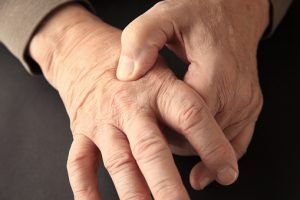 Fibromyalgia and peripheral neuropathy are two conditions that affect the central nervous system, resulting in pain. Aside from muscle pain, fibromyalgia also involves sleep disturbance, mood changes, and memory issues. It is believed to be caused by a physical trauma or psychological stress, but the exact cause is still unknown. Fibromyalgia is often accompanied by other conditions, such as anxiety, irritable bowel syndrome, and depression.
Fibromyalgia and peripheral neuropathy are two conditions that affect the central nervous system, resulting in pain. Aside from muscle pain, fibromyalgia also involves sleep disturbance, mood changes, and memory issues. It is believed to be caused by a physical trauma or psychological stress, but the exact cause is still unknown. Fibromyalgia is often accompanied by other conditions, such as anxiety, irritable bowel syndrome, and depression.
Peripheral neuropathy refers to damage caused to the peripheral nerves, resulting in weakness and numbness. Peripheral neuropathy commonly occurs in the feet or hands.
The link between fibromyalgia and peripheral neuropathy
Advertisement
Fibromyalgia and peripheral neuropathy may share common symptoms, but stem from very different causes. The cause of fibromyalgia is not understood really, while neuropathy, on the other hand, can be caused by a host of different underlying issues.
Both fibromyalgia and neuropathy affect the central nervous system and cause extreme nerve pain. Both conditions are chronic and could also share similar treatment options. In fact, both can be managed through treatment, so working with your doctor on an appropriate treatment strategy for your fibromyalgia or peripheral neuropathy can help.
Unlike fibromyalgia, peripheral neuropathy can be prevented with proper management of the underlying causes (e.g., diabetes).
Fibromyalgia vs. peripheral neuropathy: U.S. prevalence
 Roughly two to four percent of the U.S. population are affected by fibromyalgia. Estimates of U.S. prevalence were done based on the 1990 American College of Rheumatology (ACR) guidelines for the fibromyalgia diagnosis, accounting for roughly 10 million cases. It has since been argued that these estimates are too low, and the guidelines fail to capture many patients who could be living with the condition unknowingly.
Roughly two to four percent of the U.S. population are affected by fibromyalgia. Estimates of U.S. prevalence were done based on the 1990 American College of Rheumatology (ACR) guidelines for the fibromyalgia diagnosis, accounting for roughly 10 million cases. It has since been argued that these estimates are too low, and the guidelines fail to capture many patients who could be living with the condition unknowingly.
Peripheral neuropathy affects 2.4 percent of the population, but the prevalence can get as high as eight percent in certain population groups. The most common type of neuropathy – diabetic sensorimotor polyneuropathy – may be present in 66 percent of type 1 diabetics and 59 percent in type 2 diabetics.
Fibromyalgia vs. peripheral neuropathy: Signs and symptoms
The key distinguishing symptom of fibromyalgia is tender points on the body. Other signs and symptoms of fibromyalgia include chronic muscle pain, muscle spasms or tightness, moderate or severe fatigue, decreased energy, insomnia, waking up feeling unrefreshed, stiffness upon waking or after staying in one position for too long, concentration problems, difficulty remembering and performing simple mental tasks (“fibro fog“), abdominal pain, bloating, nausea, constipation alternating with diarrhea (irritable bowel syndrome), tension or migraine headaches, as well as jaw and facial tenderness. With fibromyalgia comes sensitivity to odors, noises, bright lights, medications, certain foods, and cold. Fibromyalgia patients report feeling anxious or depressed, numbness or tingling in the face, arms, hands, legs, or feet, increase in urinary urgency or frequency (irritable bladder), reduced tolerance for exercise and muscle pain after exercise, and a feeling of swelling (without actual swelling) in the hands and feet.
Signs and symptoms of peripheral neuropathy depend on the affected nerve. Nerves are classified into sensory, motor, or autonomic. Sensory nerves receive sensations, motor nerves control muscle movement, and autonomic nerves control functions such as blood pressure, heart rate, bladder, and digestion.
Some symptoms that may arise in peripheral neuropathy include:
- Gradual onset of numbness, tingling, or prickling from the hands and toes moving throughout the limbs
- Sharp, jabbing, throbbing, freezing, or burning pain
- Extreme sensitivity to touch
- Lack of coordination, falls
- Muscle weakness or paralysis
If the autonomic nerves are affected, a patient may experience heat intolerance and sweating, bowel, bladder, or digestive issues, as well as changes in blood pressure causing dizziness or lightheadedness.
Comparing fibromyalgia and peripheral neuropathy: Causes
 The cause of fibromyalgia is largely theorized, as it is not well understood. Researchers and doctors believe that a fibromyalgia patient experiences amplified pain as a result of abnormal sensory processing in the central nervous system. Much research has detected physiological abnormalities in fibromyalgia, including increased levels of substance P in the spinal cord, low levels of blood flow to the thalamus region of the brain, HPA axis hypofunction, low levels of serotonin and tryptophan, and abnormalities in cytokine function. Other fibromyalgia triggers include genetic factors and traumatic events or injuries.
The cause of fibromyalgia is largely theorized, as it is not well understood. Researchers and doctors believe that a fibromyalgia patient experiences amplified pain as a result of abnormal sensory processing in the central nervous system. Much research has detected physiological abnormalities in fibromyalgia, including increased levels of substance P in the spinal cord, low levels of blood flow to the thalamus region of the brain, HPA axis hypofunction, low levels of serotonin and tryptophan, and abnormalities in cytokine function. Other fibromyalgia triggers include genetic factors and traumatic events or injuries.
Neuropathy can be due to many other conditions and ailments, and so there is no single cause. Peripheral neuropathy is associated with nerve damage, which may be caused by alcoholism, autoimmune diseases, diabetes, exposure to poisons, medications, infections, inherited disorders, trauma or pressure on the nerves, tumors, vitamin deficiencies, bone marrow disorders, and other conditions, including diseases that affect the liver, kidneys, and thyroid.
Differentiating fibromyalgia and peripheral neuropathy: Risk factors and complications
Risk factors for fibromyalgia include sex – women are at a higher risk of fibromyalgia than men, a family history of fibromyalgia – a genetic component to the disease, and a rheumatic disease diagnosis.
One of fibromyalgia complications is poor ability to function due to lack of sleep, which worsens symptoms. Anxiety and depression, too, may be a result of fibromyalgia as it is not a well-understood condition. Living in pain can be frustrating when others simply don’t understand what you are going through, especially because there is no specific cure or treatment.
Risk factors for peripheral neuropathy include poorly controlled diabetes, alcohol abuse, vitamin deficiencies, infections like Lyme disease, autoimmune diseases, exposure to toxins, repetitive motions, a family history of neuropathy, as well as kidney, liver, or thyroid disease.
Complications resulting from peripheral neuropathy include burns and skin trauma, infection and falls due to loss of sensation – potentially leading to disability.
Fibromyalgia vs. peripheral neuropathy: Diagnosis and treatment
 There isn’t a specific test for fibromyalgia, but doctors may use a form of testing that checks 18 specific trigger points that have been found to be present in majority of fibromyalgia patients. Not all doctors use trigger point exams anymore, but rather they narrow down on a fibromyalgia diagnosis if a person has experienced widespread pain for at least three months. Your doctor may also refer you for some blood work to rule out other conditions.
There isn’t a specific test for fibromyalgia, but doctors may use a form of testing that checks 18 specific trigger points that have been found to be present in majority of fibromyalgia patients. Not all doctors use trigger point exams anymore, but rather they narrow down on a fibromyalgia diagnosis if a person has experienced widespread pain for at least three months. Your doctor may also refer you for some blood work to rule out other conditions.
Treating fibromyalgia can be difficult as its exact cause is unknown. Therefore, the goal of fibromyalgia treatment is symptom management. A doctor may prescribe analgesics, or painkillers, to address fibromyalgia. However, there is a risk of developing addiction to these drugs, so doctors may recommend this option with caution. Nonsteroidal anti-inflammatory drugs (NSAIDs) can also be taken for pain management, but once again long-term use of these drugs can yield unwanted side effects. In some cases, antidepressants may be prescribed as well.
Some alternative and complementary therapies and treatments for fibromyalgia include massages, acupuncture, cognitive behavioral therapy, movement therapies, and chiropractic.
Peripheral neuropathy is diagnosed based on a review of the patient’s full medical history and a neurological examination. Tests that could help diagnose peripheral neuropathy include blood tests, imaging tests like MRI, nerve function tests, nerve biopsy, and skin biopsy. Not only do these tests help diagnose peripheral neuropathy, but they also rule out other potential causes for your symptoms, too.
Treatment for peripheral neuropathy implies addressing its underlying cause. This could involve managing diabetes, treating infections, or treating other diseases. Some medications that may be prescribed for neuropathy include pain relievers, anti-seizure medications, topical treatments, and antidepressants.
Advertisement
Other therapies that can aid in the peripheral neuropathy treatment include transcutaneous electrical nerve stimulation (TENS), plasma exchange and intravenous immune globulin, physical therapy, and surgery.
Patients may also be inclined to try acupuncture, alpha-lipoic acid, herbs, and amino acids as an alternative mode of peripheral neuropathy treatment.
It’s of utmost important to manage and control any underlying issues that might have contributed to the disorder. For example, cutting on your alcohol consumption or managing your diabetes.
